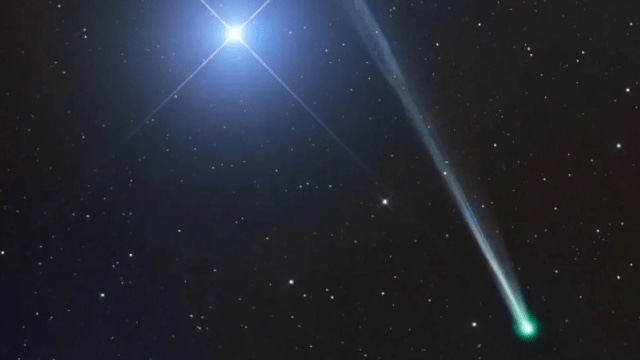Comet C/2025 R2 (SWAN) to fly by Earth on October 21: Here’s how to spot it
The comet C/2025 (SWAN) will be visible to the naked eye throughout the month, but will be most visible on October 21.
 An image of C/2025 R2 (SWAN) captured on Sept. 15 close to the blue star Spica. (Image credit: Gerald Rhemann, Michael Jaeger)
An image of C/2025 R2 (SWAN) captured on Sept. 15 close to the blue star Spica. (Image credit: Gerald Rhemann, Michael Jaeger)A newly discovered celestial body, Comet C/2025 R2 (SWAN), is set to make a close flyby of Earth later this month and might put on a spectacular show in the night sky, as it will be visible to the naked eye.
First spotted by Ukrainian amateur astronomer Vladimir Bezugly on September 10, the comet has significantly brightened since its discovery due to the heat from the sun, which caused the comet’s frozen material to transition directly from solid to gas. This very gasous shell is then blown away by the solar wind, which results in the familiar glowing long tail of dust and gas we all associate comets with.
On September 12, C/2025 (SWAN) was at its perihelion point – the closest distance to the sun, passing just 47 million miles away from our solar system’s star. According to recent observations by the Comet Observation Database, C/2025 (SWAN)’s brightness has a magnitude of 5.6, which means it could be very faintly visible to the naked eye if the sky is perfectly dark. However, it can be easily spotted using a telescope or a pair of binoculars.
To give you a quick recap, magnitude is often used to measure the brightness of an object in the night sky. The brighter an object is, the lower its magnitude will be. For example, the brightest stars have a magnitude of +1, while the full moon and sun have a magnitude of -13 and -27.
If you are interested in spotting C/2025 (SWAN), astronomers say it will be visible in the evening sky throughout October. However, the best time to spot it is right after sunset. But on October 16, the comet will be located approximately five degrees to the upper left of the Xi Serpentis star. For those not familiar with the star, try using stargazing apps like Stellarium to locate it.







